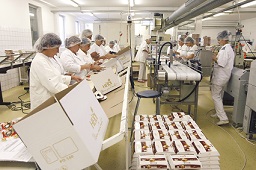
Food, its safety, its sources, its nutritional value, its effects on our overall health and so much more has become a national obsession over the past few decades, and more so now than ever with the public’s instant multimedia access to information 24/7.
For businesses involved in the food/beverage/grocery industry, it is imperative to keep up with the latest issues and decide which direction to take in order to thrive and grow. Having a trusted, central source of information and guidance in this ever-changing environment is and has been for years essential to accomplish these corporate missions. A prominent organization, the Grocery Manufacturers Association (GMA), established in 1908, says it is that source for more than 300 businesses in the consumer packaged goods industry and closely related fields. It further explains that it serves large, international brands and regional brands, as well as foodservice companies and industry service providers from consulting, technology, logistics and other sectors, some of which have been members for more than 100 years.
GMA says GMA member companies account for roughly five percent of the U.S. GDP and are constantly working to spur economic growth and create jobs. It states that the food industry it serves has 1.4 million employees and is the biggest source of U.S. manufacturing jobs. The food, beverage and consumer packaged goods industry in the United States generates sales of $2.1 trillion annually, employs 14 million workers and contributes $1 trillion in added value to the economy every year, according to GMA.
GMA has several missions, it outlines as follows:
-
GMA works to eliminate barriers to international trade and supports common-sense policies related to taxes, intellectual property and commodity prices.
-
GMA is the industry’s central resource for model practices in marketing and product distribution and offers its members a channel for collaborating with retailers to streamline these processes.
-
GMA advocates for sustainable and energy-efficient manufacturing and distribution practices for the consumer packaged goods industry.
-
GMA strives to ensure that all consumer packaged goods meet the highest standards of safety.
Recently, two food-related issues have gained national attention, namely, food waste and food manufacturers’ and food retailers’/ wholesalers’ role as it pertains to food waste, as well as the issue of GMOs (genetically modified organisms). GMA has addressed both of these concerns with public announcements, and their responses follow.
Food Manufacturers and Retailers Benchmark Food Waste Metrics
The food industry issued its first-ever analysis of food waste data collected directly from food manufacturers, retailers and wholesalers. The study was conducted by consulting firm BSR and commissioned by the Food Waste Reduction Alliance (FWRA), a cross-sector industry initiative led by the Grocery Manufacturers Association (GMA), the Food Marketing Institute (FMI) and the National Restaurant Association (NRA).
The report found that food waste generated through manufacturing tends to be unused ingredients, unfinished product or trimmings, peels and other unavoidable food waste. The large volume of food and relatively few manufacturing sites create economies of scale that allow manufacturers to recycle waste at a high rate. Conversely, food waste at the retail level tends to consist of finished products more suitable for donation. Numerous locations and diverse product offerings make food waste diversion a significant logistical challenge for many retailers.
The analysis demonstrates how the industry operating environments are recognizably different, but survey respondents cited common barriers that prevented them from diverting more food waste from landfill. Transportation constraints and liability concerns were the most commonly cited barriers for food donation, while the most frequently reported obstacle to food recycling was an insufficient number of recycling options.
Manufacturers and Food Waste
“The primary objective of the Food Waste Reduction Alliance is to reduce the volume of food waste sent to landfill by addressing the root causes of waste, and securing pathways to donate safe food or recycle it for use elsewhere. This new data not only helps us better understand how industry currently is managing food waste, it gives us a benchmark against which we can measure our progress,” said Susan Kujava, industry relations director at General Mills, Inc. and co-chair of the FWRA.
Key findings from the manufacturing sector:
-
Food manufacturers diverted 94.6 percent of food waste generated from landfills to higher uses, such as donation and recycling.
-
Nearly three-quarters (73 percent) of food waste diverted by manufacturers went to animal feed.
-
The manufacturing sector donated 700 million pounds of safe food that would have otherwise been disposed.
 Retailers/Wholesalers and Food Waste
Retailers/Wholesalers and Food Waste
“The findings uncovered by BSR are encouraging, but it’s clear we can and must do better when it comes to reducing food waste,” said Michael Hewett, director of environmental and sustainability programs, Publix Super Markets, Inc. and co-chair of the FWRA. “It’s important to find more ways to keep food and food waste out of landfills, identify the challenges that prevent us from doing so, and develop responsible policies to assist in these efforts.”
Key findings from the retail/wholesale sector:
-
Food donation and composting were retailers’ and wholesalers’ primary diversion methods (representing 32 percent and 43 percent of diverted food, respectively).
-
Retailers/wholesalers donated 670 million pounds of safe food that would have otherwise been disposed.
-
The retail/wholesale sector diverted the majority (55.6 percent) of food waste generated from landfills to higher uses.
BSR’s analysis is based on self-reported survey data collected from food manufacturers and grocery retailers/wholesalers extrapolated to the entire U.S. food manufacturing sector and grocery retail/wholesale sector. In total, 13 manufacturers responded to the survey (representing approximately 17 percent of U.S. manufacturing sales) and 13 retailers/wholesalers responded (representing approximately 30 percent of U.S. grocery retail/wholesale industry sales). Data reported was for the year 2011.
Grocery Manufacturers Association Position on GMOs
The use of genetically modified (GM) ingredients is not only safe for people and our planet, but also has a number of important benefits.
Many of the most influential regulatory agencies and organizations that study the safety of the food supply, including the U.S. Food & Drug Administration, the American Medical Association, the World Health Organization, Health Canada, the U.S. Department of Agriculture and the National Academy of Sciences, have found genetically modified food ingredients are safe and there are no negative health effects associated with their use.
GM technology adds desirable traits from nature, without introducing anything unnatural or using chemicals, so that food is more plentiful.
It is important for our consumers to know that this technology is not new. In fact, it has been around for the past 20 years, and today, 70 to 80 percent of the foods we eat in the United States, both at home and away from home, contain ingredients that have been genetically modified. If the ingredient label on any food or beverage product contains corn or soy, it most likely contains genetically modified ingredients, as a very high percentage of those crops grown in the U.S. use GM technology. In addition, a high percentage of other ingredients in the U.S., such as sugar beets, are grown with the use of GM technology as well.
Ingredients grown using GM technology require fewer pesticides, less water and keep production costs down. In fact, GM technology helps reduce the price of crops used for food, such as corn, soybeans and sugar beets by as much as 15 to 30 percent. In addition, one in eight people among the world’s growing population of seven billion do not have enough to eat, and safe and effective methods of food production, like crops produced through GM technology, can help us feed the hungry and malnourished in developing nations around the world.
